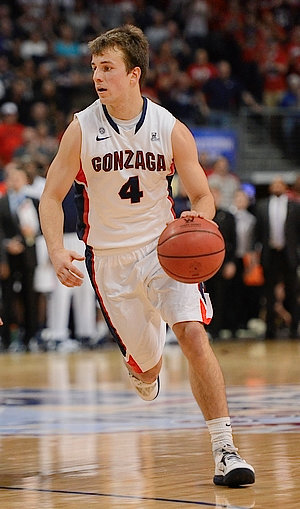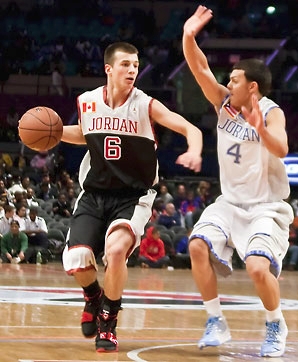
Kyle Nelson
The last time that we checked in on Kevin Pangos, the Canadian point guard had solidified himself as one of the best young point guards outside of the United States. Thus, few were surprised when he stepped into a starting role right away en route to being honored as the West Coast Conference (WCC) Newcomer of the Year, twice named to the All-WCC Team, and landing on the Naismith Award Pre-Season Watch List before his sophomore season.
In his two years at Gonzaga, Pangos has led the Bulldogs to a 58-10 record with back-to-back NCAA Tournament appearances, the school's first top-ranking and #1 NCAA seeding in school history, and a WCC Championship.
Yet, despite his many accolades, he is by no means a surefire NBA prospect, and as he prepares for his junior season, he must prove to scouts that he has what it takes to play in the NBA.
His biggest challenge will be overcoming his below average physical profile. Though he has average size for a point at guard at 6'2 with a 182-pound frame, his sub-6'0 wingspan does him few favors. Likewise, his first step leaves quite a bit to be desired, and he lacks even average explosiveness, though he does show shifty quickness in half court settings.
On the offensive end of the floor, Pangos has distinguished himself as a steady, efficient point guard and one of the best perimeter shooters in college basketball. True to his reputation, nearly three-quarters of his field goal attempts were jump shots last season, and he takes far more shots outside of the arc than inside of it. That being said, he saw fewer possessions in a more talented rotation and averaged just 15.0 points per 40 minutes pace, 2.1 points less than during his freshman season.
Fortunately, he remains an elite perimeter shooter, making 42% of his 5.5 three point attempts per game. On film, he shows outstanding mechanics, notably a quick and compact release, which allows him to get his shot off, even against bigger and more athletic defenders. He also made 36.4% of his jump shots off the dribble - many from beyond the arc. It must be noted, however, that his lack of size does affect his shooting ability at times, as he makes only 27.8% of his contested jumpers.
He also lacks a particularly quick first step and advanced ball handling, resulting in frequent struggles to get around quicker defenders on his way to the basket. When he is able to pick up speed and find his way into the lane, he ultimately struggles to finish at the rim, making just 42.3% of his overall attempts. His 44% 2P%, down from 48% as a sophomore, ranks him in the bottom half of point guard prospects in our database. He is actually a better finisher than one would expect due to his solid body control and a dependable floater, but he will likely continue to struggle both in the WCC and at the next level due to his physical limitations.
Showing scouts that he can attack the basket more effectively and improving on his paltry 3.0 free throw attempts per 40 minutes pace adjusted would likely assuage, at least temporarily, concerns about his athleticism.
An area of intrigue, however, is his versatility in running the pick-and-roll, While fairly limited as a half-court scorer at this point and not really a danger to create his own shot, he is a tough mark due to the fact that he can both find rolling big men and knock down jumpers off of the dribble. Solid is a good way to describe his point guard play across the board, as he is not a particularly flashy or creative player, but he rarely turns the ball over and sports an impressive 2.27 assist/turnover ratio despite playing 32.8 minutes per game. He already displays good court vision, but his handles and inability to get into the lane are both areas in which improvement could go a long way to positively affecting his prospects.
Pangos is an engaged defender, compensating somewhat for his average physical profile with focused and aggressive play. Most immediately, his 1.9 steals per 40 minutes pace adjusted are a testament to his effort on the defensive end of the floor. On film, he does a great job of moving his feet and running over and fighting through screens while defending the pick-and-roll, even if he struggles to stay in front of more athletic guards. Yet, despite his efforts, offensive players have little trouble shooting over him due to his short wingspan, and he struggles to close out on perimeter shooters. Unfortunately, while Pangos is a good defender in college, it's extremely difficult to see him performing at the same level as a professional due to his physical limitations.
Thus, it will be interesting to see how Pangos builds on his sophomore year. Playing alongside an experienced starting lineup of Gary Bell Jr. Przemek Karnowski, Sam Dower, and Providence transfer Gerard Coleman should give Pangos plenty of options as a distributor, as well as the space to find his own offense when necessary. Likewise, if summer reports can be believed, then scouts expect to see a better-conditioned player, improved as a shot creator and more adept at getting into the lane. While his weaknesses are undeniable and his ceiling is not particularly high, he will continue to garner interest from NBA scouts should he lead Gonzaga to another winning season. Pangos has already amassed an impressive resume and though his professional future is far from certain, there is still plenty of time for him to boost his stock in the eyes of NBA scouts.



























Comments